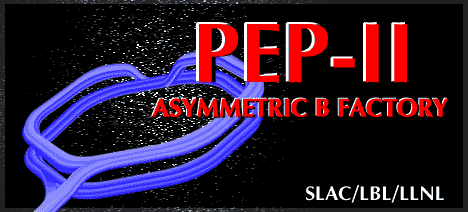 11/01/00 Update
11/01/00 Update  11/01/00 Update
11/01/00 Update PEP-II Update November 1, 2000
The
PEP-II and BaBar data taking run ended last night after a very successful
finish. Since May 1999 through October 2000 PEP-II has delivered 25.6 fb-1 and
BaBar has logged 23.5 fb-1. The best integrated luminosity delivered in a day
was 174 pb-1. Our best month was October 2000 during which 3.65 fb-1 were
delivered. The design values for a day and a month are 135 pb-1 and 3.3 fb-1,
respectively. PEP-II has easily exceeded these design values.
During
most of the summer the beam current in the HER was administratively limited to
ease stress on a failing vacuum joint in the HER high power dump. For the last
three weeks of the run the HER current was slowly raised and the luminosity
followed. On Sunday October 29 at 6 am the luminosity exceeded 3x10**33 /cm**2/s
for the first time. Later that day the luminosity reached 3.1 x 10**33. This
luminosity was achieved using 692 bunches with 1550 mA of positrons and 792 mA
of electrons. The bunches were spaced every three RF buckets in 70 short trains
of 10 bunches each. The beta x and y at the collision point were 50 cm and 1.25
cm, respectively. BaBar successfully collected data with good beam lifetimes and
backgrounds with a luminosity starting at 3.02 x 10**33. Thus, we are very
pleased to announce that PEP-II has exceeded its design luminosity of 3.0 x
10**33.
The
last three days of October were devoted to machine studies. Here are several of
the major results:
A new
PEP-II current record was achieved in the LER of 2140 mA positrons in 1660
bunches (which equals the design current). The e+ beam was longitudinally stable
but was mildly unstable transversely which will be studied during the down.
Several
coasting beam fills with BaBar were tried with a bunch pattern having every
other bucket filled. This bunch spacing is the design pattern (called the
"by-2" pattern) having potential parasitic crossing effects.
With full colliding currents and the by-2 bunch pattern the nominal peak
luminosity was nearly achieved (95%) in a few hours. This bodes well for the
future when we will try for higher luminosity with more bunches.
Over
the past few months, a PEP-II vacuum bellows next to the beryllium vacuum
chamber in the center of BaBar has developed elevated temperatures at the higher
beam currents. Studies were made of the heating of this component under various
beam conditions (current, bunch length, number of bunches, orbit offsets and
angles). During the shutdown we will compile this data and try to predict the
future expected temperatures and possible remedies if needed.
The
transverse size of the positron beam is enlarged at high currents by the
electron cloud instability from multipacting electrons, as is now commonly seen
in several accelerators. A solenoid capable of 30 gauss has been wrapped on the
straight section vacuum chambers to suppress these electrons. A length of 500 m
has been wound resulting in a luminosity increase of order 50% over the past
months. With the present solenoids the size enlargement starts at about 1300 mA
and is seen in both the vertical and horizontal planes. PEP-II is now embarking
on a program to wind solenoids in the LER bending arcs to suppress multipacting
and photo-electrons there. About 200 chambers each 5 m long need to be covered.
Two new
tune locations in LER were tried with anticipated hopes of increasing the
luminosity. First, the nominal fractional LER x and y tunes of 0.65 and 0.58,
respectively, were moved to near 0.71 and 0.58. At these tunes, the horizontal
beam size began to increase near the 0.75 tune line.
The best luminosity after 8 hours work was about 75% of the original.
Second, the LER x and y tunes were moved to near the HER fractional tunes
of 0.57 and 0.64, respectively. After 8 hour of work, the luminosity performance
was worse giving only about 50% of that of the original tune location.
Thus, the original LER tunes are still the best.
Finally,
the LER wiggler was turned off last February to reduce the LER beam size at the
collision point to increase the luminosity. Most of the loss in luminosity from
the wiggler was traced to a strong induced x-y coupling. Nothing in the wiggler
magnetic measurements data would indicate such a strong coupling. In addition to
generating radiation, the wiggler changes the orbit length due to the trajectory
wiggles and, thus, moves the beam orbit radially over all of LER. As a test
during the machine studies, a similar radial orbit shift was made by changing
the RF frequency while looking at the x-y coupling. The lattice as designed
should not couple the beams with a radial orbit shift. However, the RF frequency
shift did change the coupling and about as much as the wiggler did. Thus, we
likely have a lattice not a wiggler problem.
During
the three month shutdown, several large installation tasks will be performed. A
new HER high power dump downstream of the interaction point will be installed.
The LER Arc vacuum system in Region 7 will receive needed repairs. New LER
interaction region collimators will be installed. LER arc solenoids will be
wound. A HER pulsed beam separator will be installed near the interaction point.
The positron source will have several key components replaced. Finally,
additional shielding will be installed at several places around PEP-II.
PEP-II
and BaBar will turn on February 1 and run until August 31, 2001. The goals for
PEP-II by the end of August are a peak luminosity of 5 x 10**33 and to integrate
an additional 35 fb-1.
Congratulations
to all for reaching the design luminosity and thanks to
John
Seeman for the PEP-II Staff 11/1/2000
Suggestions to: John Seeman
[PEP-II Commissioning Updates] [PEP-II Home Page] [BABAR Detector Home Page] [SLAC Home Page]
Page owner: achan